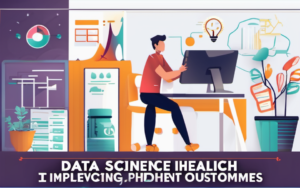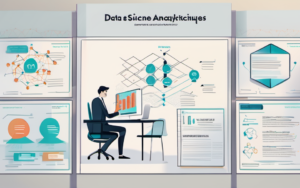The success of your data science projects hinges on choosing the right algorithms. Algorithms are the heart of data science, enabling you to extract meaningful insights and build predictive models. This guide will walk you through the process of selecting the most suitable algorithms for your specific needs, providing you with the knowledge to make informed decisions and maximize your project’s effectiveness.
Choosing the Right Algorithms for Your Data Science Projects
Introduction
Data science projects involve various tasks, from analyzing trends to building predictive models. To achieve these goals, you need to select the right algorithms to process and analyze your data effectively. This choice is crucial because different algorithms are designed for specific tasks and data types.
Understanding Your Data
The first step in algorithm selection is to understand your data. This includes its type, structure, and quality.
Data Type
The type of data you’re working with will influence the algorithms you can use. For example, if you have numerical data, you can use linear regression. If you have categorical data, you might choose a decision tree or a support vector machine.
Data Structure
The structure of your data also matters. Structured data, like spreadsheets, is easily processed by algorithms. Unstructured data, such as text or images, requires different approaches and algorithms.
Data Quality
The quality of your data is crucial. Inaccurate or incomplete data can negatively impact the performance of your algorithms. Cleaning and pre-processing your data before selecting algorithms is essential.
Defining Your Project Goals
Before selecting algorithms, define your project goals. This will guide you toward the right algorithms.
Predictive Modeling
If you’re building a predictive model, you’ll need to choose between regression and classification algorithms depending on your target variable.
- Regression algorithms predict continuous variables, like house prices or stock prices.
- Classification algorithms predict categorical variables, such as whether a customer will churn or not.
Clustering
Clustering algorithms group data points with similar characteristics. They’re useful for tasks like customer segmentation or anomaly detection.
Dimensionality Reduction
Dimensionality reduction algorithms reduce the number of variables in your dataset without losing significant information. This can improve the efficiency and accuracy of your algorithms.
Algorithm Selection
Once you understand your data and project goals, you can choose the appropriate algorithms.
Supervised Learning
Supervised learning algorithms learn from labeled data to make predictions.
Regression Algorithms
- Linear Regression: Predicts a continuous target variable based on a linear relationship with input variables.
- Logistic Regression: Predicts a categorical target variable based on a logistic function.
- Decision Tree Regression: Builds a tree-like structure to make predictions.
- Random Forest Regression: Combines multiple decision trees to improve accuracy and reduce overfitting.
- Support Vector Regression: Finds the optimal hyperplane to separate data points and predict continuous values.
Classification Algorithms
- Logistic Regression: A popular algorithm for binary classification problems.
- Decision Tree Classification: Builds a tree-like structure to classify data points.
- Random Forest Classification: Combines multiple decision trees for improved accuracy.
- Support Vector Machine (SVM): A powerful algorithm that finds the optimal hyperplane to separate data points into different classes.
- Naive Bayes: Based on Bayes’ theorem, this algorithm is simple and effective for text classification and spam filtering.
- K-Nearest Neighbors (KNN): Classifies data points based on their proximity to known data points.
Unsupervised Learning
Unsupervised learning algorithms learn from unlabeled data to discover patterns and relationships.
Clustering Algorithms
- K-Means Clustering: Groups data points into K clusters based on their distance from cluster centroids.
- Hierarchical Clustering: Creates a hierarchical tree-like structure to cluster data points based on their similarity.
- DBSCAN: A density-based algorithm that identifies clusters based on the density of data points.
Dimensionality Reduction Algorithms
- Principal Component Analysis (PCA): Reduces the dimensionality of data by finding principal components that explain most of the variance.
- Linear Discriminant Analysis (LDA): Reduces dimensionality while maximizing the separation between classes.
- t-Distributed Stochastic Neighbor Embedding (t-SNE): A non-linear dimensionality reduction technique for visualizing high-dimensional data.
Evaluating Algorithm Performance
After choosing algorithms, you need to evaluate their performance on your data.
Metrics for Evaluation
Different metrics are used to evaluate algorithm performance based on the type of problem. Common metrics include:
- Accuracy: The percentage of correctly classified data points.
- Precision: The ratio of correctly predicted positive instances to the total number of predicted positive instances.
- Recall: The ratio of correctly predicted positive instances to the total number of actual positive instances.
- F1-score: The harmonic mean of precision and recall.
- Mean Squared Error (MSE): A common metric for evaluating regression models.
Cross-Validation
Cross-validation is a technique for evaluating the performance of your algorithms on unseen data. It involves splitting your data into multiple folds and training the algorithm on different folds.
Conclusion
Choosing the right algorithms is crucial for successful data science projects. You must understand your data, define your project goals, select the appropriate algorithms, and evaluate their performance rigorously.
Key Takeaways
- Understand your data: Data type, structure, and quality are crucial for algorithm selection.
- Define project goals: This will guide you toward the right algorithms for your task.
- Evaluate algorithm performance: Use appropriate metrics and cross-validation to ensure your chosen algorithms perform well.
Further Exploration
The world of data science algorithms is constantly evolving. Explore online resources, research papers, and online courses to stay updated on the latest advancements and learn about new algorithms.




